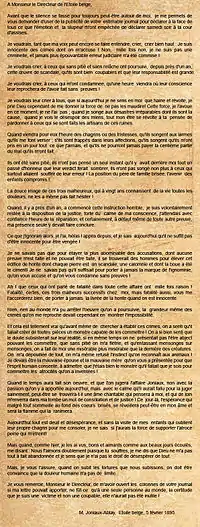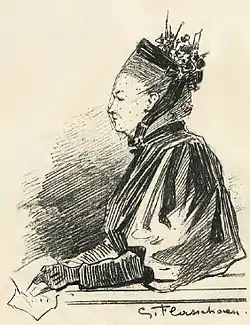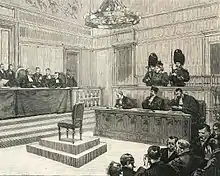Marie-Thérèse Joniaux
Marie-Thérèse Joniaux (née Maria Teresa Joséphe Ablaÿ; October 15, 1844 – 1923) was a Belgian poisoner who made headlines in 1894–1895 as part of the Joniaux Affair after the triple poisoning perpetrated against her sister, Léonie Ablaÿ, her uncle-by-marriage, Jacques Van de Kerkhove and her brother, Alfred Ablaÿ. She was sentenced to death on February 3, 1895.[1] Her death sentence was commuted to life imprisonment, and she died in Antwerp in 1923.
Marie-Thérèse Joniaux | |
|---|---|
.jpg.webp) | |
| Born | Maria Teresa Joséphe Ablaÿ October 15, 1844 Mechelen, Belgium |
| Died | 1923 (aged 78–79) Antwerp, Belgium |
| Conviction(s) | Murder |
| Criminal penalty | Death; commuted to life imprisonment |
| Details | |
| Victims | 3 |
Span of crimes | 1894–1895 |
| Country | Belgium |
Early life
Marie Ablaÿ was born in Mechelen on October 15, 1844 into a family from Mons that had many high-ranking soldiers from the early 19th century. Her father, Jules-Gustave Ablaÿ, followed the family tradition and became Lieutenant-General and the King's aide-de-camp. Her uncles Omer and Narcisse were also generals in the fledgling Belgian army. Her mother, Thérèse de Ryckman de Betz, gave birth to six children; as the eldest and "with the liveliest intelligence," Marie-Thérèse is said to have been her father's favourite child.
Marriages
At age 24, Ablaÿ finally decided to marry; on July 10, 1869, she married Frédéric Faber, a well-known bibliophile on the Grand Place in Brussels who was often lost in his research and publishing his opuscules. On February 3, 1871, a child was born from this union: Jeanne Faber. But the new parents did not get along, as Faber, an intellectual, took care of his research, and Ablaÿ devoted considerable energy to maintaining a standing befitting of her rank. Faber died on December 4, 1884 in circumstances that were considered suspicious. Having respected the period of widowhood as prescribed, Ablaÿ married a second husband: Henri Joniaux, the widower of Ida Dumon, with whom he had three children: Marguerite, Marthe, and Charles. He was a Chief Engineer and First Class Director at the Bridges.
Indebtedness
The couple soon settled into a lush hotel, at 33 Nerviens Street off Boulevard Leopold in Antwerp. Her first marriage had left Ablaÿ with many mortgage and unsecured debts. Real-estate sales wiped out the first, but Ablaÿ still owed part of the second. Their daughter Jeanne, although still a minor, inherited a comfortable amount from her father, which would also be stolen by her mother.

Coming from a wealthy family, Ablaÿ had no intention to live a modest life. She tried to find money through honest legal ways, but eventually turned to illegal means to support her lifestyle. She flagrantly cheated on her husband in Brussels and Spa, but denied it fiercely. She resorted to a mount of piety and sometimes for derisory amounts (75 Belgian francs on May 12, 1887).[Notes 1] She locked herself into a spiral of indebtness. On May 11, 1888, she obtained a loan from her mother-in-law of 30,000 Belgian francs as the result of one of thousands of missives she wrote her, imploring her, saying that "we will have a catastrophe if you can not do anything", implying that her son, from disappointment, would put an end to his days. The assets of her daughter, Jeanne Faber, came in guarantee and the act is passed on May 29, 1888. On June 1, 1888, she was at a pawnshop to deposit silver for a fee of 140 Belgian francs. On August 31, 1888, a watch and a pin of her husband expired a year earlier; she is unable to redeem them and had to renew her commitment. The 30,000 Belgian francs were repaid the most virulent creditors. However, the persuasive Ablaÿ knew how to extract money from her family and acquaintances. She began to plan her ploys. There was one that she was particularly fond of at this time: she had to pay off a debt contracted by a family member to spare the family honor. In early 1890, she embarked on another lucrative activity: she became a master singer and sent anonymous letters threatening to stigmatize those who did not comply with her financial requirements. She tried to blackmail her brother-in-law's son Lionel, who was found dead on the edge of a pond in Lubbeek, on October 26, 1890.

In January 1892, Jeanne Faber married Oswald Mertens. Marie-Thérèse Joniaux could not imagine a marriage without luxury. Her financial situation was burdened, and she saw no way out. She made a life-insurance policy on her sister Léonie for an amount of 70,000 Belgian francs from two insurance companies. She pretended it to be a financial operation and did not give any details. Léonie, attracted by the preparations of Jeanne's nuptials, moved to live with her sister in Antwerp. Her health began to decline, and doctors assumed she was suffering from typhus. The first doctor was called at 2:00 AM on February 24, 1892. Insurers executed and closed the insurance in March and in April 1892. Marie-Thérèse Joniaux then went on holiday in Monaco and Italy.
She settled some debts but in October and November, she was again at a financial loss. One evening, Joniaux's uncle, Jacques Van de Kerkhove, came to a family dinner. After eating his meal, he said he felt ill and went to bed; the next day he died at around 11AM. Doctors speculated that he had cerebral apoplexy. Her husband inherited the money, but Joniaux needed fresh and directly-accessible cash. She then proposed to her son-in-law to offer her the possibility of taking out a loan of 25,000 Belgian francs by agreeing to put her buildings in the guarantee. For the price of all the trouble, he would receive a brokerage of 5,000 Belgian francs. It was short-lived and in June 1893 she was again at bay.
In June 1893, she engaged in a new type of transaction, demonstrating the compelling nature of finding money. She bought a credit for 900 Belgian francs of silverware from a jeweler to hasten, immediately putting a nail to the mount of piety. She reiterated that tactic with two other jewelers in January and in February 1894. The instruction understood the underlying gestures.
Joniaux affair
On February 4, 1894, her brother, a former cavalry captain, was forced to resign due to financial misfortune. A widower since 1871, he settled in Paris where he had a relationship with a mistress, Marie Roguet, was attracted to Antwerp by his sister. He had just lost his job in Paris and planned to beg for an alimony from his son, Georges. Alfred was jobless in Paris until he found a job as a bookkeeper. He also benefitted from a small supplementary pension paid by his mother-in-law, Madame Meskens. He lost his job, and called his sister who said that she wanted to help him. She offered to pay him an annuity in exchange for an insurance on his life worth 100,000 Belgian francs, of which she would be the beneficiary. He contacted a company in Paris but the conditions did not satisfy Joniaux, because of the high monthly payments. He arrived in Belgium, and his sister took things in her hands, contacting a London company named Gresham who had a seat in Antwerp. On February 17, 1894, the policy was underwritten and the first quarterly bonus was paid by Joniaux. She explained to the insurers that this is to cover important advances that she made to her brother and that she wanted to benefit her children. Alfred Ablay died at his home on the night of March 5 or 6, 1894.

Dr. Willems, deceived by the words of Marie-Thérèse Joniaux from a previous consultation in Brussels with a colleague, concluded that a heart problem was the reason for the death. The company Gresham was not convinced and immediately filed a complaint with the public prosecutor in Antwerp, triggering the Joniaux affair. Joniaux was arrested on April 17, 1894. The trial, led by Eugène Hayoit de Termicourt, lasted nine months. The trial took place on January 7 and February 3, 1895. 296 witnesses were heard. Joniaux was sentenced to death and transferred from the prison of Antwerp to that of Mons where she arrived on June 6, 1895 to serve his sentence, which was commuted to life imprisonment.
She tried to appeal her sentence but it was rejected. She wrote a memoir. Marie-Thérèse Joniaux died in Antwerp in 1923, at the age of 79.
Bibliography
- Albert Bataille, Criminal and worldly causes of 1895, The poisoner of Antwerp, E. Dentu, Paris, Available online in Gallica p. 151
- Raymond de Ryckère, The Joniaux affair, triple poisoning - indictment, report of the medical experiments and chemists: MM. of Visscher, Baisieux, Van Vyve, G. Bruylants and Herman Druyts, voice from beyond the grave (memory of Mrs. Joniaux), study of the trial, by Mr. Raymond de Ryckere, A. Storck, Lyon, 1895, available online on the BNF.
See also
Notes
- An employee that earns 2300 Belgian francs per year
References
- Raymond de Ryckère, L'affaire Joniaux, triple empoisonnement - acte d'accusation, rapport des médecins-experts et chimistes : MM. de Visscher, de Baisieux, Van Vyve, G. Bruylants et Herman Druyts, voix d'outre-tombe (mémoire de Mme Joniaux), étude du procès, par M. Raymond de Ryckère, A. Storck, Lyon, 1895, consultable en ligne sur la BNF.